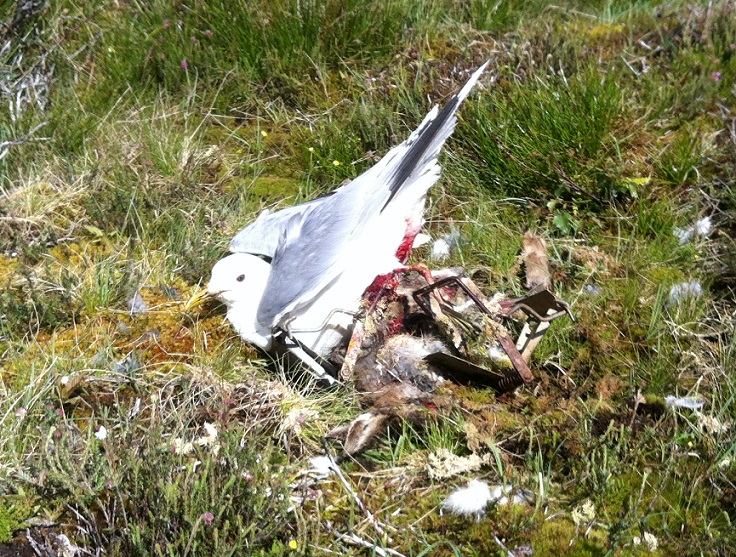
The news of a poisoned Golden Eagle being found next to a poisoned Mountain Hare on Invercauld Estate (see here) led me to reflect on the afternoon I found a trapped gull on that estate in June 2016. While this received publicity at the time, some of it excellent, (see here), I have never told my part in the story. I have decided I should now make that public and write about the afternoon I spent on that estate in June 2016 and the aftermath. My article describes a tormented, tortured creature that I discovered in one of Scotland’s national parks. It is an account of my attempt to seek change in order to mark its death, and prevent other people from experiencing a similar distressing scene.
It was a calm and sunny day and I was engaged in voluntary wildlife survey work with a friend. We knew each other from our careers in environmental management and were enjoying catching up on a day in the hills. Invercauld is one of the estates in the area that erected numerous ‘Welcome To The Moor’ signs with information on beneficial effects of grouse moor management on biodiversity, and colourful pictures of the animals you might see while out and about.
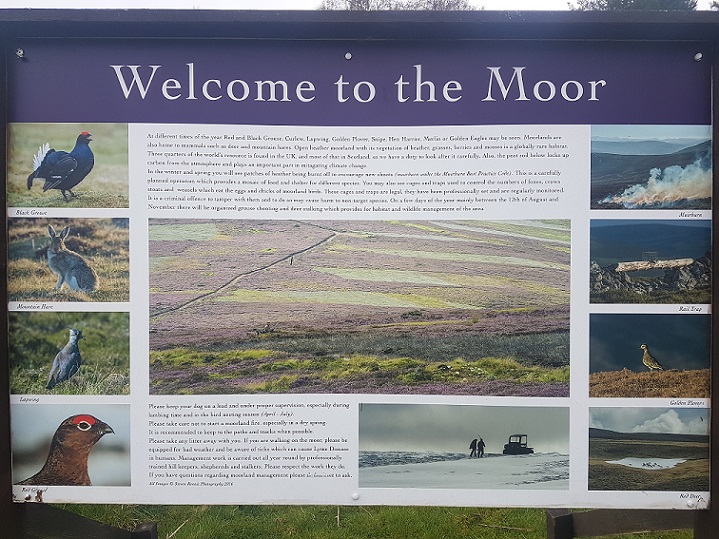
We were walking on Geallaig Hill when I noticed a gull repeatedly popping up above the heather line and just as quickly disappearing below it. Curious to see what was causing this unusual behaviour, and fearing the worst, we approached it. Each of its legs was gripped by a metal spring trap that had been baited with dead rabbit at the edge of muirburn.
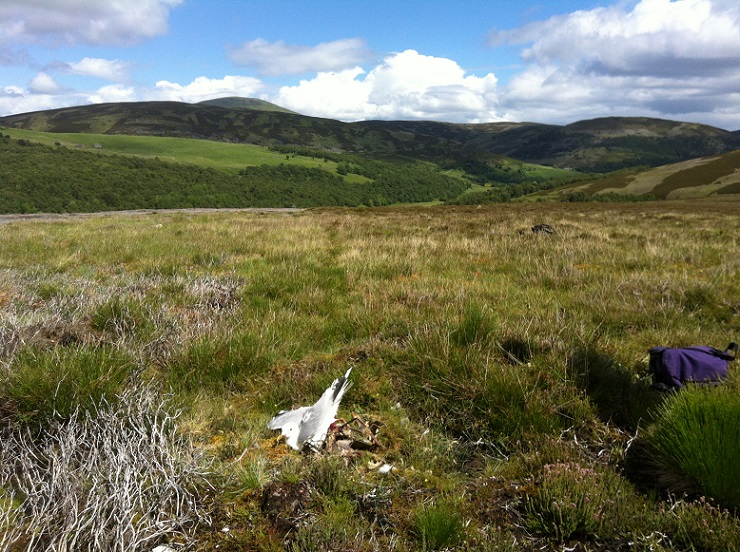
Each trap was secured to chains tethered by a stout wooden stake driven firmly into the ground. I took some photographs but they do not portray the relentless, pathetic flapping of the bird as it endeavoured to escape. A video would have been more poignant. Every few seconds, as the bird tried to fly away it pulled the traps off the ground until the chains were taught and it was jerked back. Goodness knows how long it had repeated this futile effort, but the chains were pulling its legs off and its lower breast and vent were stained crimson.
If you enjoy watching birds, and admire and envy the freedom of their flight, seeing one of them fatally injured yet still trying to flee cruel traps is a hard watch. Unless you set traps like that in the open, the natural reaction is to release the bird in the forlorn hope that it may yet be saved. I spoke to the RSPB Investigations Unit who alerted SSPCA. I covered the bird with my coat to try to calm it down and prevent it flying off, as with two broken legs, one of them badly mangled and hanging loose, I thought it would otherwise suffer a long, lingering death.
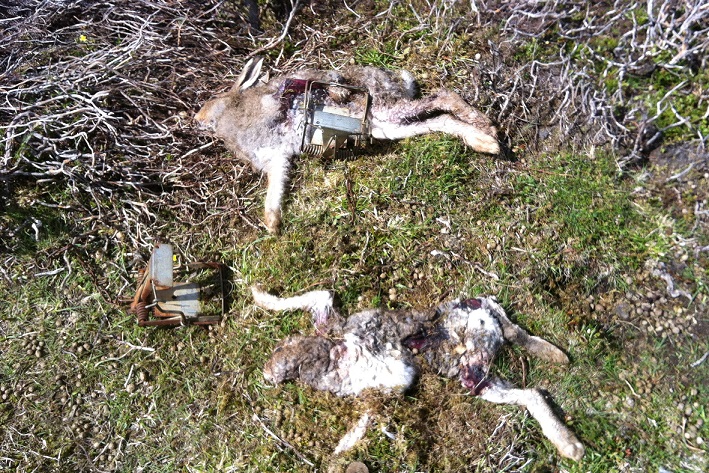
On the walk back to the road to wait for assistance my friend found more spring traps at the edge of the same burnt area. Again there were two tethered traps baited with rabbit. Later, while we waited on the roadside verge for assistance, we saw a man dressed in camouflage gear drive past us in a white SUV. He turned right to access the moor by an adjacent track.
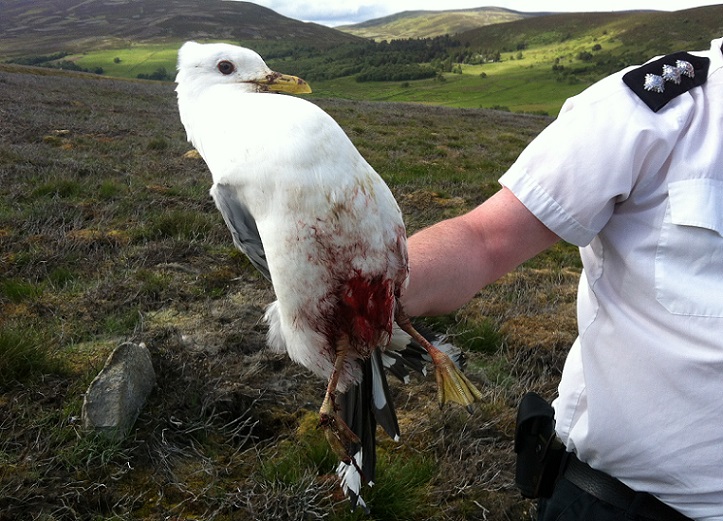
The SSPCA officer arrived. I was glad and very appreciative that he managed to get there so quickly and I escorted him to the location of the gull. He decided it couldn’t be saved so I held it while he gave it a lethal injection. As it died I watched the life switch off in its eyes and vowed I would do what I could to try to stop the barbaric behaviour that had killed it. I could see the white SUV parked high up on an adjacent hill. The SSPCA officer bagged the dead gull, traps and stake and took them as evidence. I showed him the separate traps and he sprang them but left them in situ. As we walked off the hill I saw the SUV move off the hill. We were standing by the SSPCA vehicle with obvious logos when the SUV driver passed us on the road. He did not stop to talk to us.
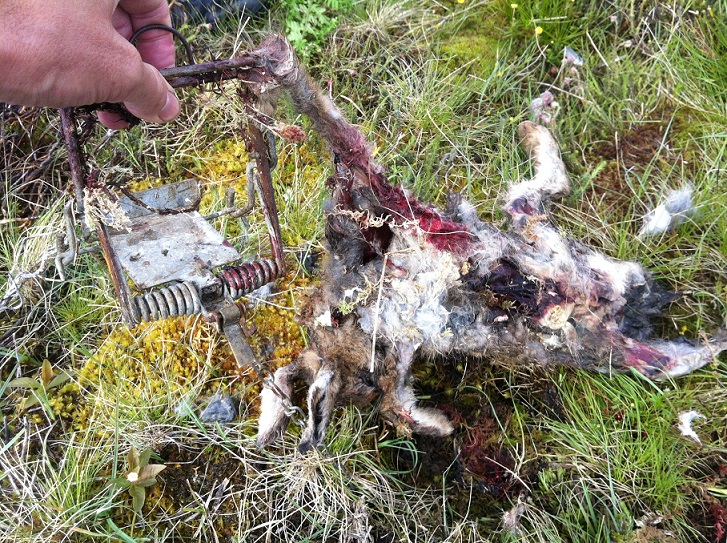
A multi-agency search took place a few days later. Clear evidence was found that eight similar traps had been deployed, attached to stakes and baited with dead rabbits, in a line stretching two hundred metres across the moor. It was also evident that these traps had been removed very recently. Whoever had set the two traps that caught the gull had time to remove the remaining traps before the police investigation(see here).
Regardless of no traps being found during that search, the sight of the gull caught in the traps had been witnessed by two people and the existence of set and baited traps had been witnessed by three people, with photographic evidence. There was no evidence regarding who had set the traps, but the presence of the traps on Invercauld Estate had been corroborated.
Subsequent events
As the incident had happened in a national park, and after reading his comments in newspaper coverage of the incident, I wrote to Peter Argyle the Cairngorm National Park Authority (CNPA) Convener. In the article Park Talk from our new Convener Peter Argyle – Cairngorms National Park Authority Peter talked about
“... designing places that encourage physical activity, by using our unmatched natural environment for recreational activity and generally by working together to encourage healthy lifestyles. Which all sounds a little bit worthy; but what it means is all of us can be fitter and healthier by spending more time out of doors. And if we are to spend more time out of doors, where better than right here?”
I wanted to get the message across to Peter and the CNPA that having to watch a gull pull its own legs off because it was caught in illegally set traps, and having to spend two hours of an otherwise pleasant day waiting for someone so that I could help them kill the blood-stained creature, wasn’t the sort of unmatched natural environment I had expected. I could easily think of thousands of better places to spend time outdoors than Cairngorms National Park. For example I’ve just returned from a week in Orkney. There are heather moors but they aren’t managed intensively. There is biodiversity and the habitat seemed richer and more rewarding to walk in. There were no geometric patterns of scorched earth, no regimented, bulldozed mounds topped with medicated grit. No ugly traps on wooden poles stretching across burns. No open stink pits containing rotting deer and hare corpses.. No cheap chicken wire funnel traps big enough to catch eagles.
I hoped people being paid public money to manage the national park could influence land management within the park for the better.
After the gull incident became public an Invercauld Estate spokesman stated “We understand the police have not found evidence of illegal activity and our own enquiry has led to a similar conclusion. Nevertheless, we are extremely concerned by such an allegation and condemn outright any unlawful activity on Estate property. Our staff have been well trained in the law relating to moorland management and remain vigilant to any illegal activity whether this is intended to discredit the grouse industry or for other reasons.” (see here).
I read this as a sly insinuation against myself and my friend who are both environmental professionals with a sincere interest in wildlife. I saw it as a ‘nothing to see here and if there was any evidence it was planted to discredit the estate’ sort of response. I wasn’t convinced anyone would buy such an argument.
Later in July, Grant Moir CEO of the Cairngorms National Park said “It is appalling that spring traps have been illegally set resulting in the death of a common gull. The law on the use of traps is clear and it is simply unacceptable for them to be used in this way. I have this morning asked for a meeting with the Head Trustee of Invercauld Estate and with the Sporting Partner to discuss these issues.”
Peter Argyle alerted me to these meetings by email and at that time I was happy with the response of CNPA. Peter also promised to keep me posted with any developments. Each time an incident of persecution, or suspected persecution was reported from the park I reminded Peter about his obligation. The excellent Raptor Persecution UK blog was most helpful in this respect. There was the suspicious disappearance of a White-tailed Eagle and two Hen Harriers. Then another Hen Harrier disappearing in suspicious circumstances. A Golden Eagle photographed with a trap hanging from its legs. Then in July 2020 a poisoned White-tailed Eagle found in Cairngorms National Park.
Here is the text of the reply I received from Peter.
“When Grant Moir and I met the shooting tenant regarding Invercauld I did not take any notes as it was a private meeting; however we did discuss the terrible incident with the gull and were told that a keeper had been ‘let go’ – by which I assume dismissed – as a consequence. We discussed grouse moor management and raptors and did what we could to get across the message on these issues. I don’t think either of us expected anything hugely significant to come out of the meeting; it was very much part of a long-running effort to make land managers understand their responsibilities with regard to these questions. That effort continues of course. As you will be aware I am no longer Convenor of the CNPA and so my direct involvement in these discussions is not what it was.”
The news I received about someone being ‘let go’ tallied with information I had received from another of the witnesses.
“I have a sergeant coming today to take a statement from me about the traps at West Milton. They have been trying to arrange one from you too as you probably know. They intend to try and revoke their general licence to deploy traps. They also tell me one keeper has been sacked and the others given final written warnings.”
I don’t know if anyone lost their job following the incident, but if they did it doesn’t seem to tie in with the estate saying there was no evidence of illegal activity.
Two meetings between myself and the police were cancelled late in the day due to them having to attend to more urgent business, so I handed my signed and dated witness statement in at Banchory police station.
Wildlife Crime Officer PC Doug Darling later told me my statement appeared to have gone missing before any officers had read it so I sent him a copy by email.
In April 2017 I had the following exchange with Scottish Natural Heritage.
Me: “It was nice to meet you again yesterday. Over lunch I raised the subject of the gull incident and was rather disturbed to hear you say SSPCA had failed to collect the trap as evidence. You’re the second person who has told me that and it’s incorrect. Can you recall where that story came from? I’d like to put it right – a trap was definitely taken away by SSPCA and I included that information in my witness statement”.
Me: “Further to our brief chat I’ve just spoken to PC Doug Darling. As I suspected he wasn’t aware the two traps that held the gull were recovered from the hill. Also he hadn’t seen my witness statement and is trying to track it down. I’m pleased I called him to clarify what had happened.”
SNH (now NatureScot): “Thanks for keeping me in the loop.
Yes, I was chatting with Doug and said that we’d spoken. I explained that you had observed SSPCA remove the traps from the hill and that you had provided a witness statement to the police.
Doug said that as the case was initially taken on by SSPCA the witness statement may have been passed to them. In any case Doug said he’d get to the bottom of it, which I’m confident he will.”
After we spoke I couldn’t recall whether it was the police or RSPB who had told me about the traps not being uplifted (or what now seems to be that they were uplifted but not lodged as productions with the police, for whatever reason), however I can confirm that both RSPB and police were of the same opinion.
I’m sure Doug will find out what happened as he’s very capable”
Me: “I’ve just spoken to RSPB Investigations who knew the traps had been removed by SSPCA. To be honest I’ve had enough of the merry-go-round. Hopefully some lessons will be learnt.”
SNH: “I think you’ve done the right thing and bring this to Doug’s attention, as there are clearly mixed messages depending on who is spoken to.
What seems clear is that the police do not have a statement nor the traps, which need to be addressed, and although I think it’s very unlikely anything will come of it in terms of criminal prosecution you are right that the procedure needs to be looked into, whether it be from the police, SSPCA or both sides.”
In May 2017 I was reminded about General License restrictions by an article on the Raptor Persecution UK blog (see here). A General License, issued by NatureScot, allows estates to undertake activities such as the killing of wildlife, subject to conditions. A restrictive General License can be imposed following evidence of wildlife crime, subject to the police forwarding an evidence pack. They seem to me to be a mild form of punishment but, in cases where evidence won’t be heard in court, better than nothing as they presumably arrive with reputational consequences.
I wondered if such a restriction had been applied to Invercauld Estate. As it turned out SNH did not issue a General License restriction and did not give reasons for their decision as they deemed it not in the public interest.
The experience and its aftermath left me dazed and confused. I’ve seen new legislation created, people moved on, wildlife crime officers stepping into retirement and SNH rebranding itself. The line-up changes but the song remains the same.

A very powerful but disturbing article. Well done for pursuing the cause.
This article starts with a photo of the infamous “Welcome to the Moor” signs which have been erected by Invercauld and other estates in the Cairngorms. Under a section headed OBSERVE THE SCOTTISH OUTDOOR ACCESS CODE the signs say “It is recommended to keep to paths and tracks when possible.” This exhortation does not appear in the SOAC and is a blatant attempt by Invercauld and the other estates in the Cairngorms who use this sign to misrepresent the rights of public access to land that were secured by part 1 of the Land Reform (Scotland) Act 2003. It can be assumed that any estate that uses such Welcome to the Moor signs has something happening away from the paths and tracks, including possible illegal activity, that they do not want the public to observe. Also, many of these signs carry the logo of the Cairngorms National Park Authority. I understand that no permission was sought from the CNPA to use their logo in this way.
The problem of these signs is a long running saga which was described nearly 4 years ago by Nick Kempe on parkswatchscotland (4 Dec 2017). The CNPA have known that these signs are non compliant with the 2003 Act even longer – while requests to keep to paths and tracks may be appropriate in particular locations and time of year they are definitely non compliant when applied to large tracts of land such as whole moorland areas. So far the CNPA appear to have taken no action to deal with this signage problem, giving further encouragement to those land managers who persecute our wildlife with impunity.
I’ve been asked by gamekeepers to let them know beforehand where I’m going to be monitoring raptors, including twice by a gamekeeper on Invercauld. Given that evidence disappeared before the police investigation following the gull incident, I don’t think that would be a good idea.
Play their game. Tell them where/ when you are going then go somewhere different. If you’re lucky you may just catch them at some illegal activity. Also carry a copy of that days paper so that you can prove the date of the incident.
Or tell them what you found on their estate but not where….then wait and see who turns up to clear up.
Good call. I hoped the investigators would sort that out but no such luck.
Distressing, depressing and predictable. Who’d have thought it … This, presumably, will be one of the reasons why Invercauld has withdrawn from the East Cairngorms partnership (whose formal name escapes me). Too much scrutiny.
https://cairngorms.co.uk/invercauld-estate-leaves-the-east-cairngorms-moorland-partnership/
Does CNPA have anything to say on Invercauld Estate being a member of the East Cairngorm Moorland Partnership for approaching five years since the gull incident?
Too many conflicts of interest to ever get justice for these birds…
Perhaps Fergus Ewing stepping down might allow a bit more progress on such issues.